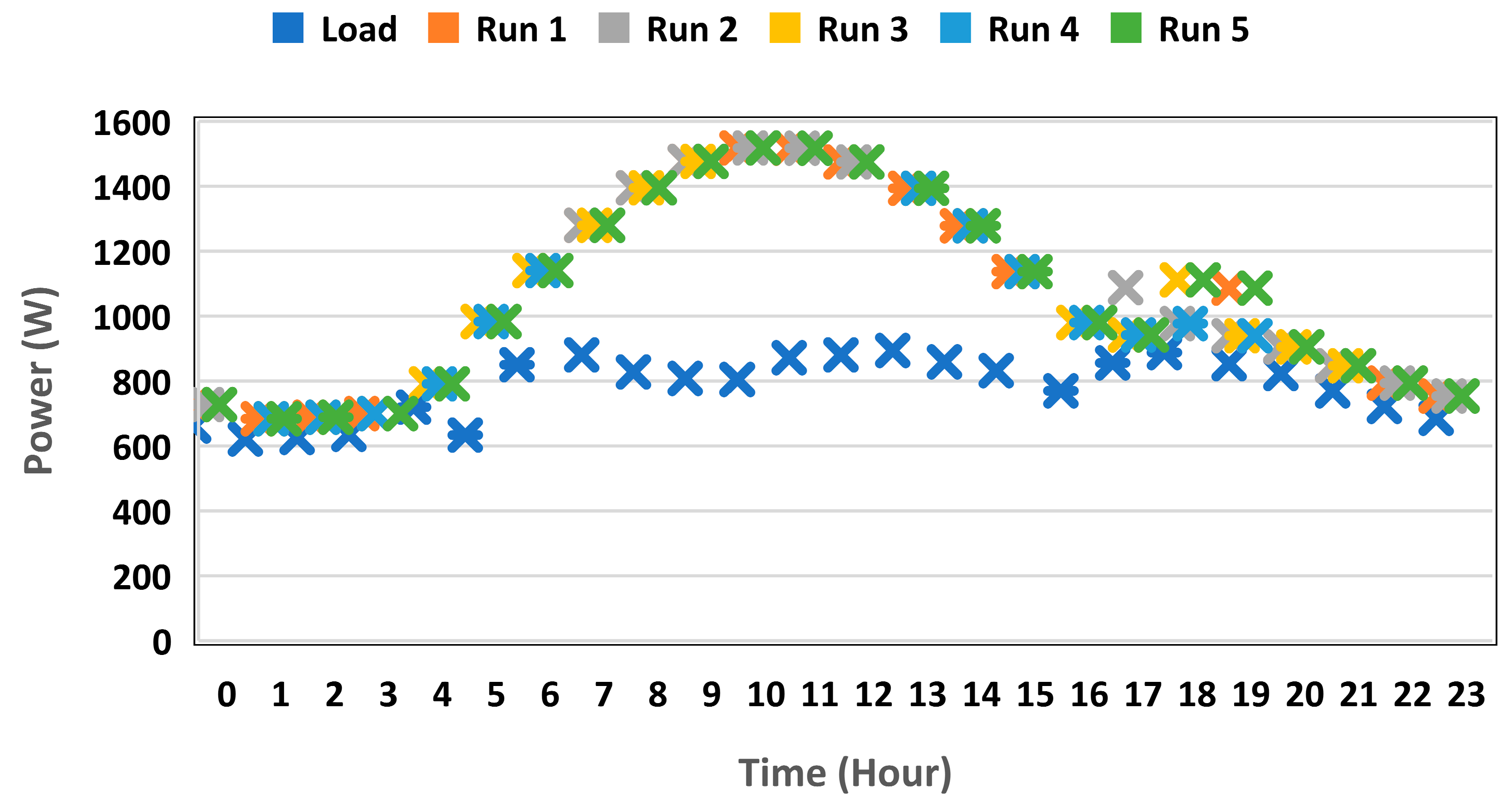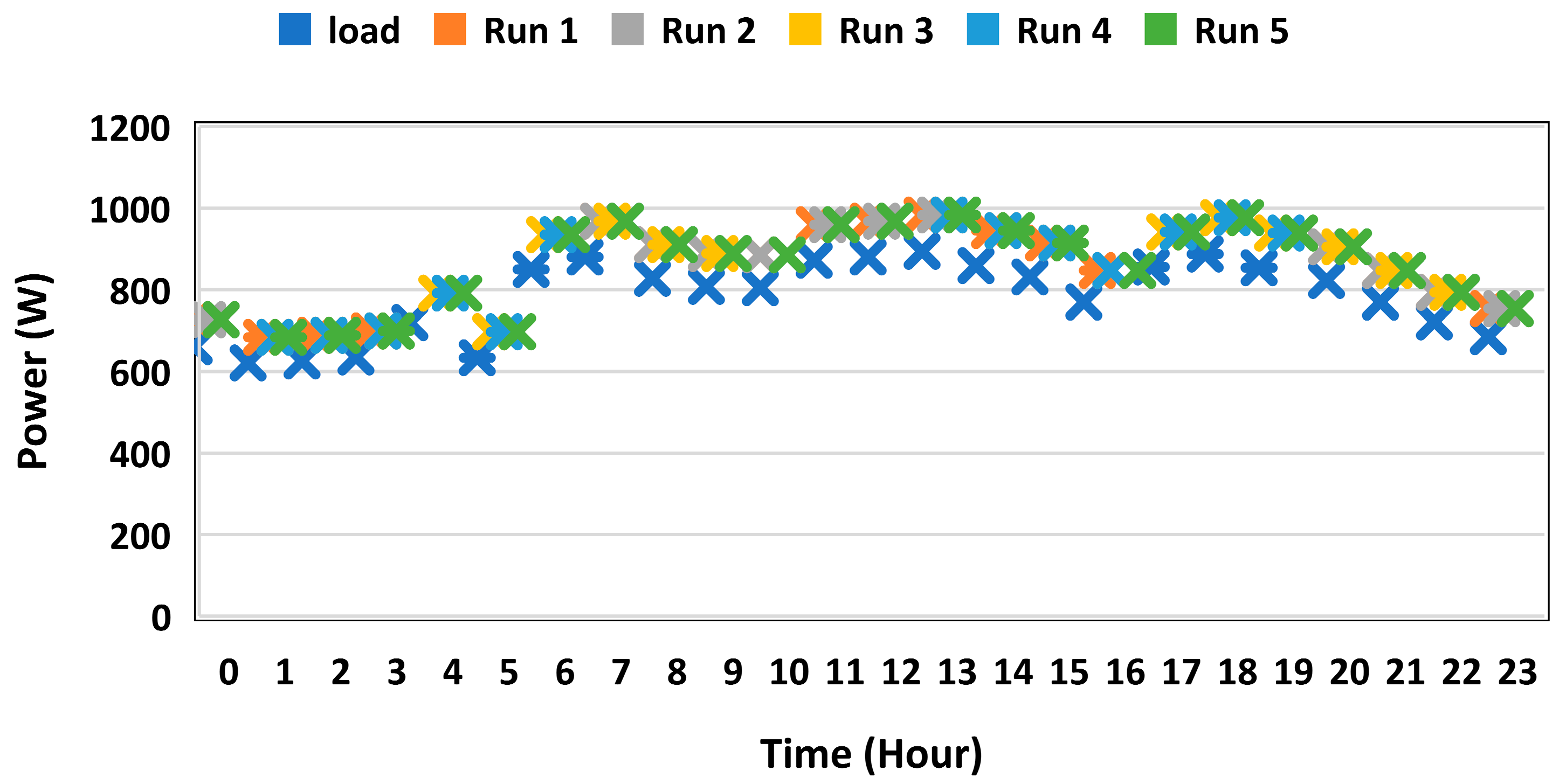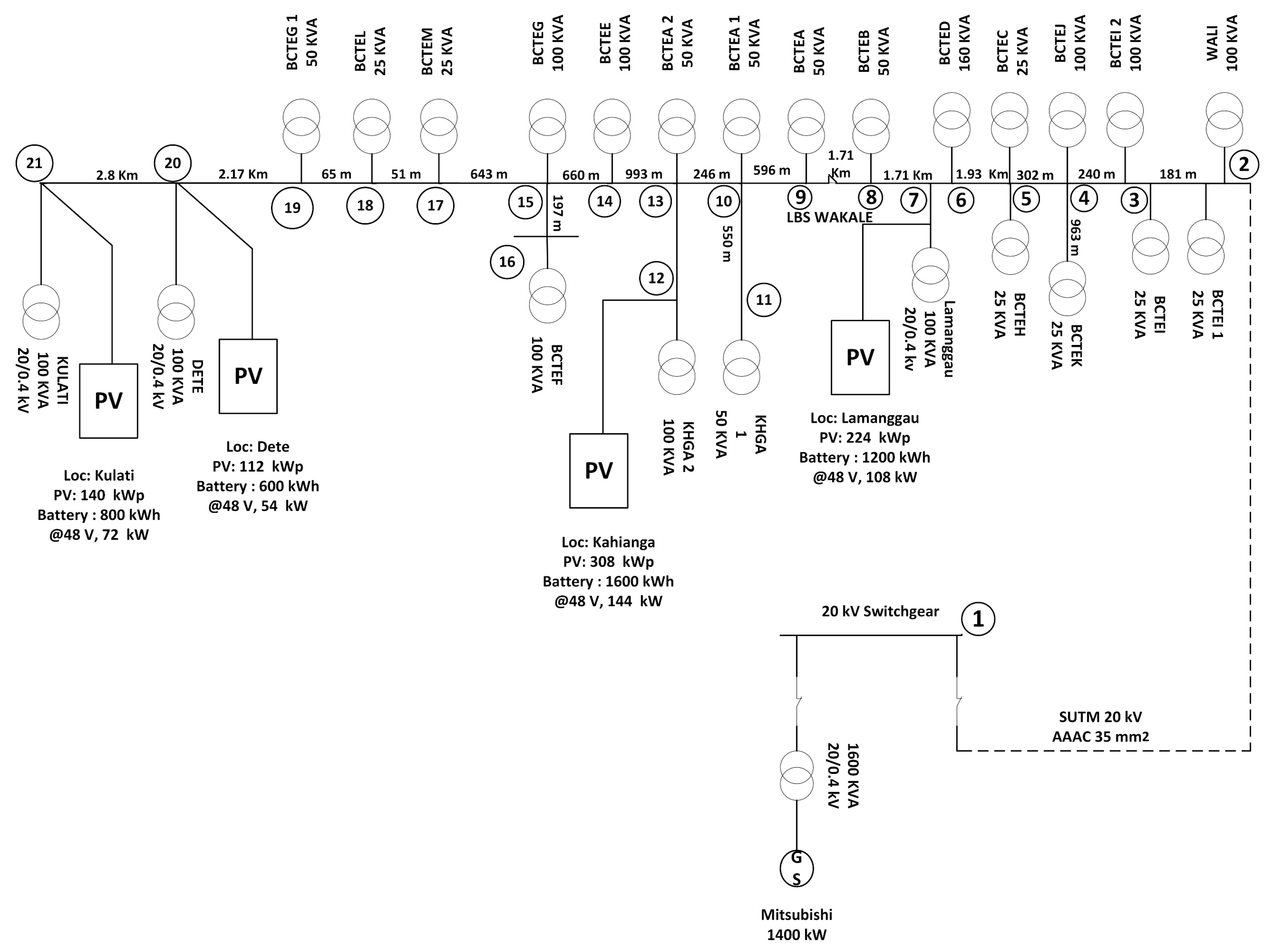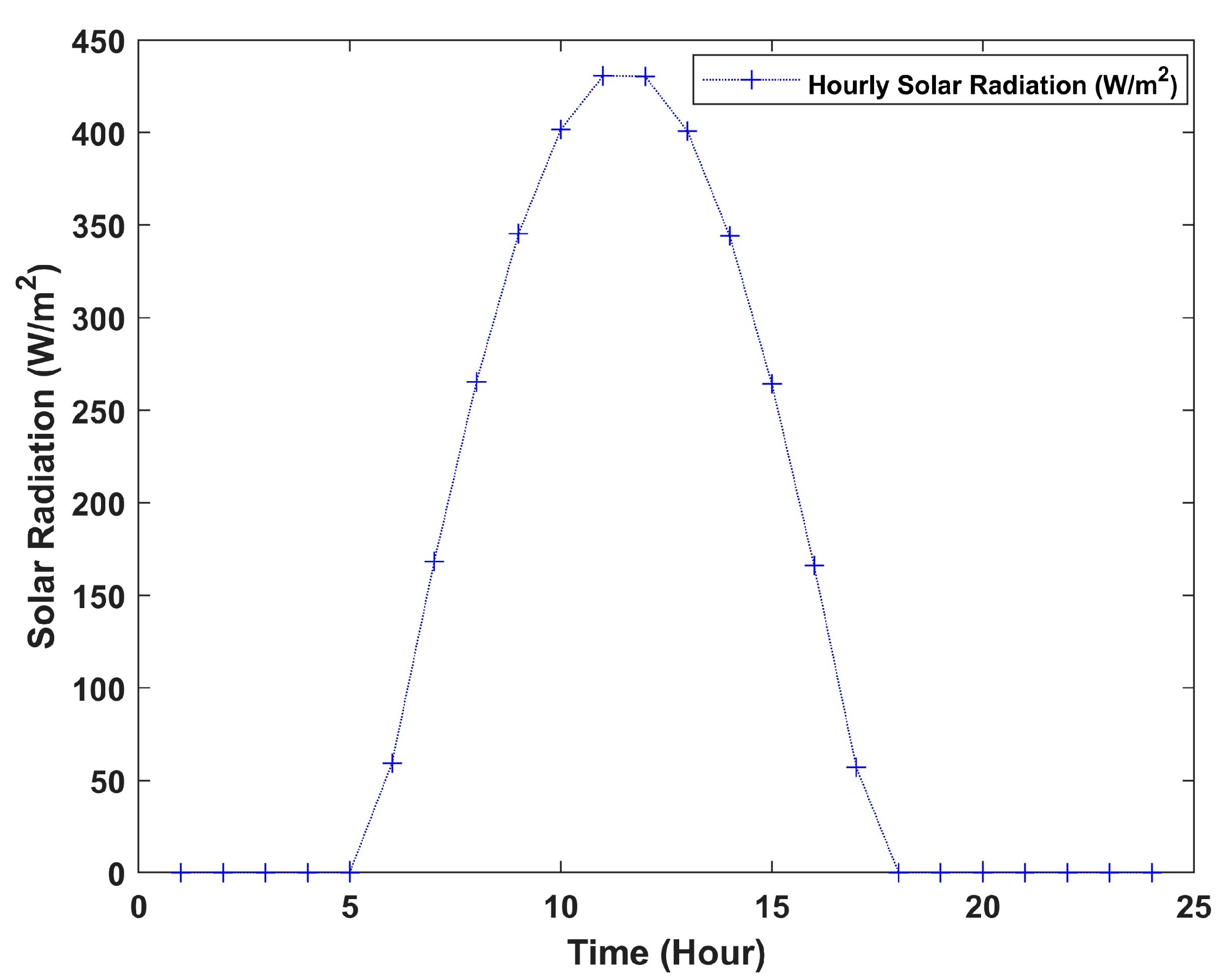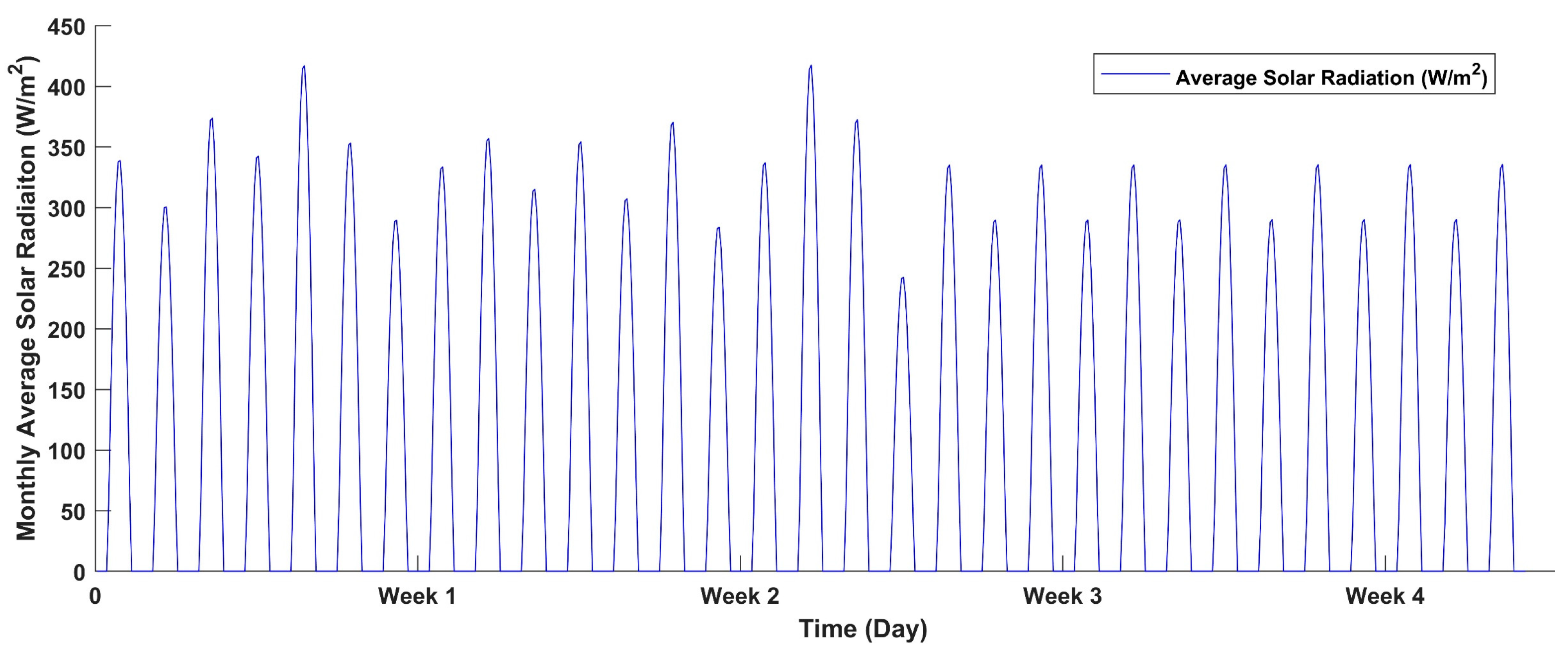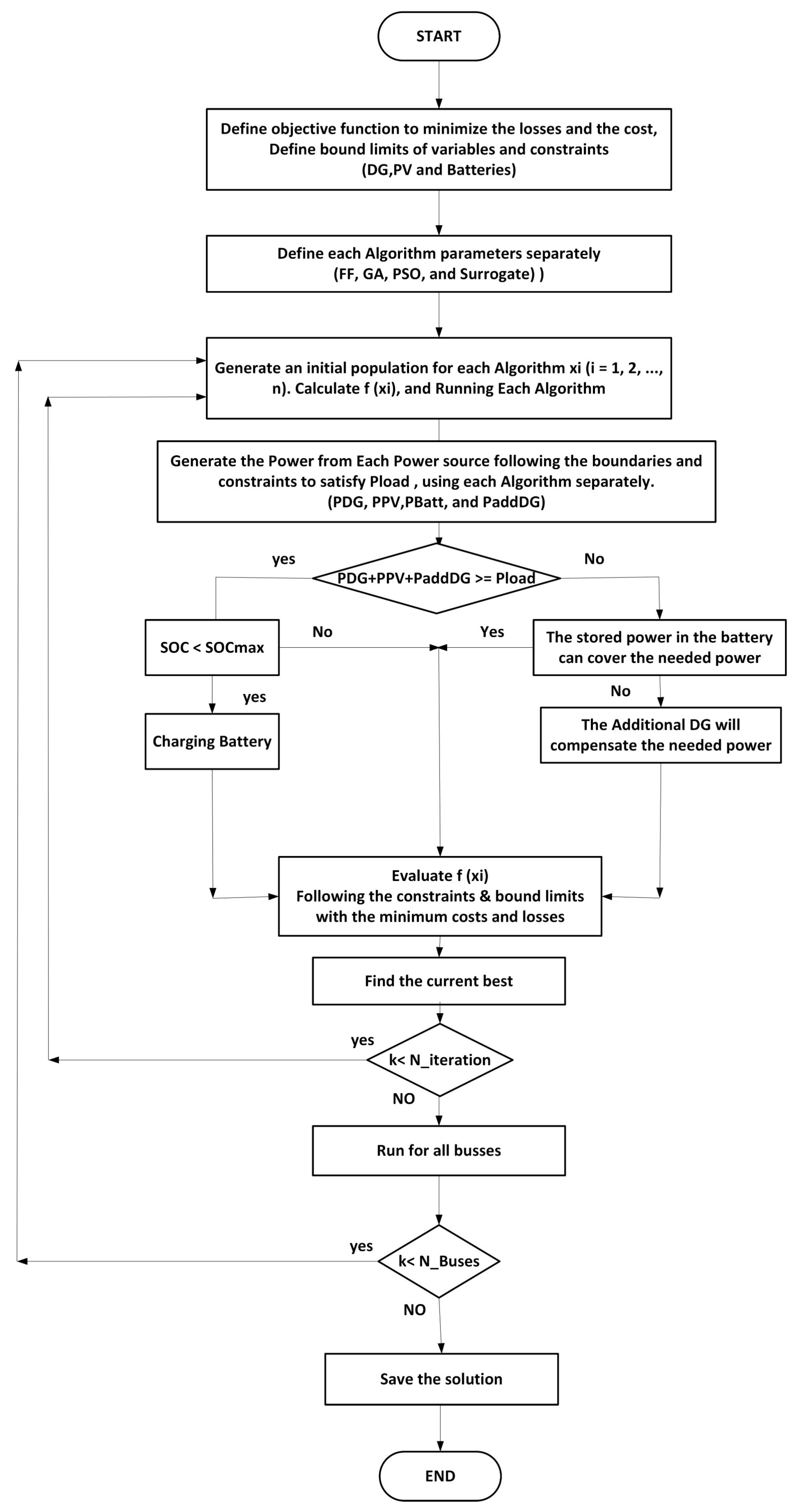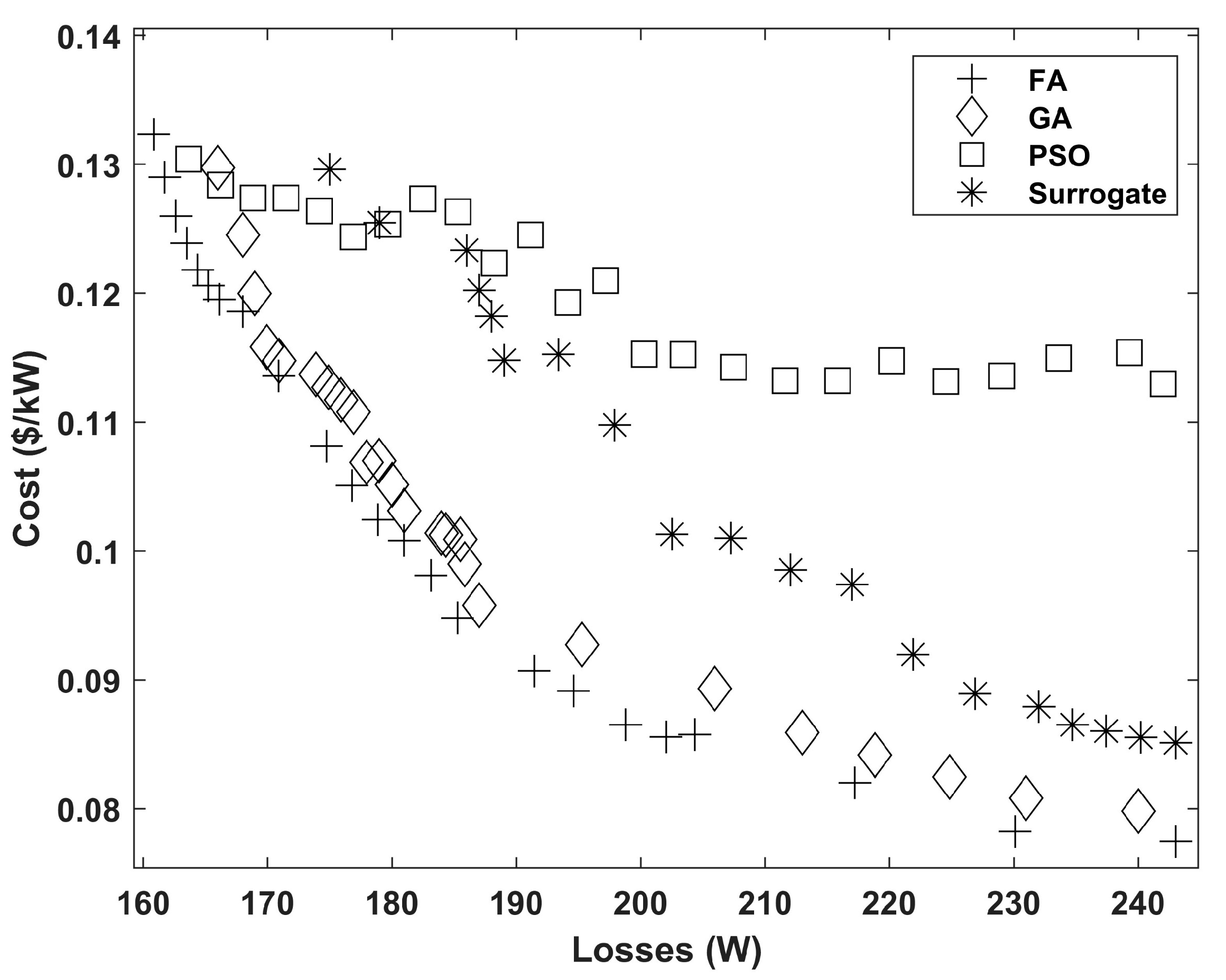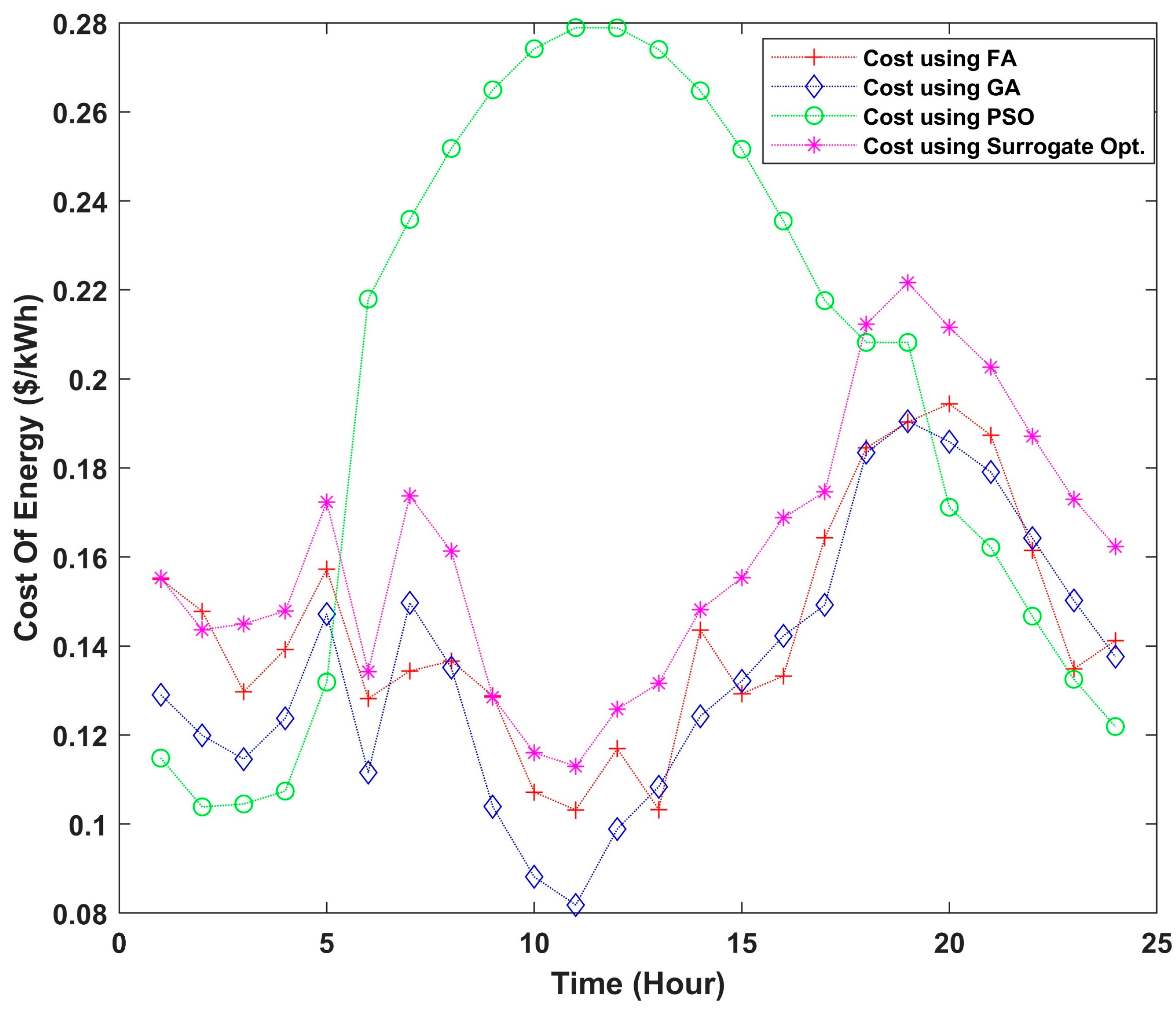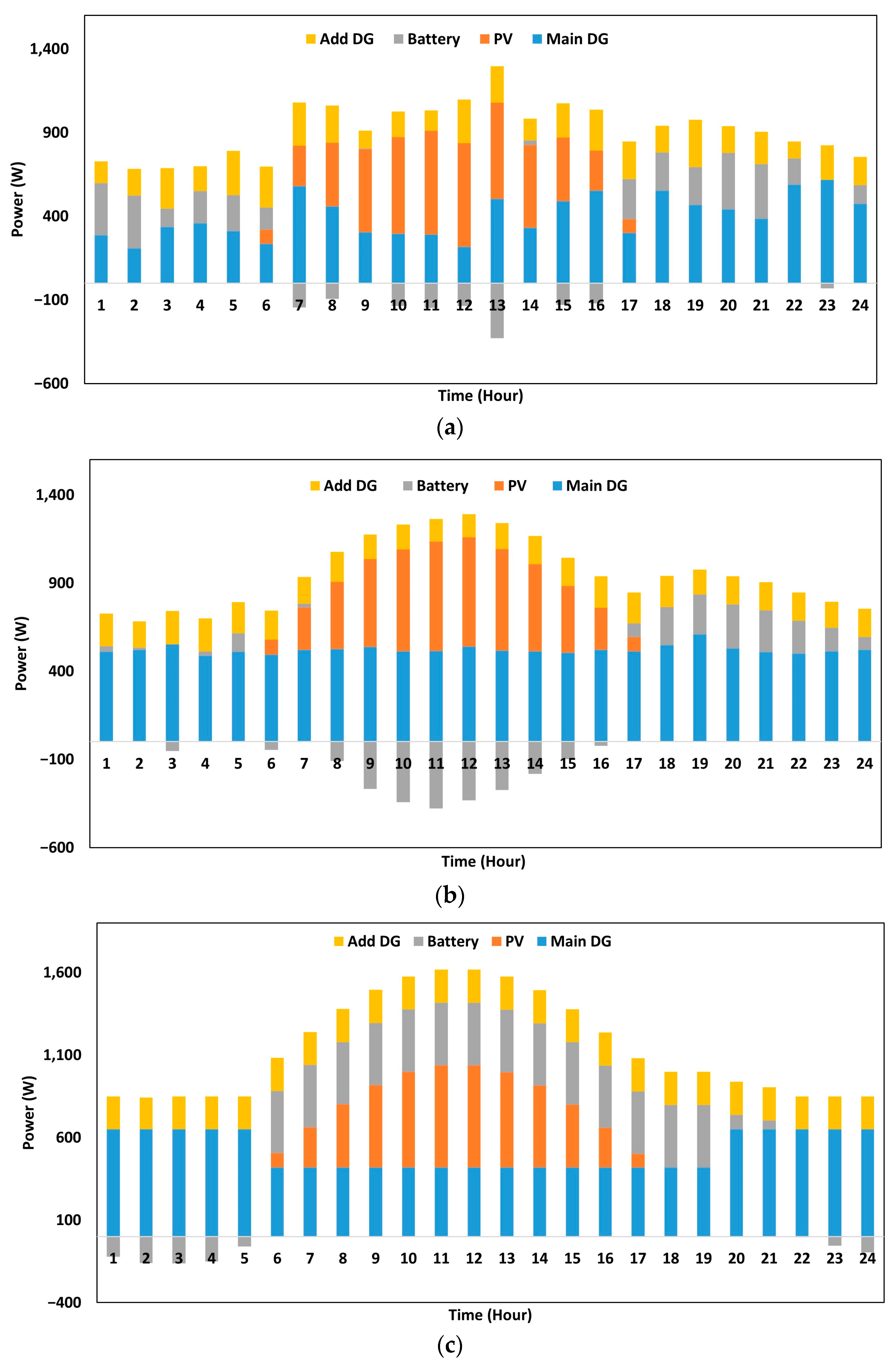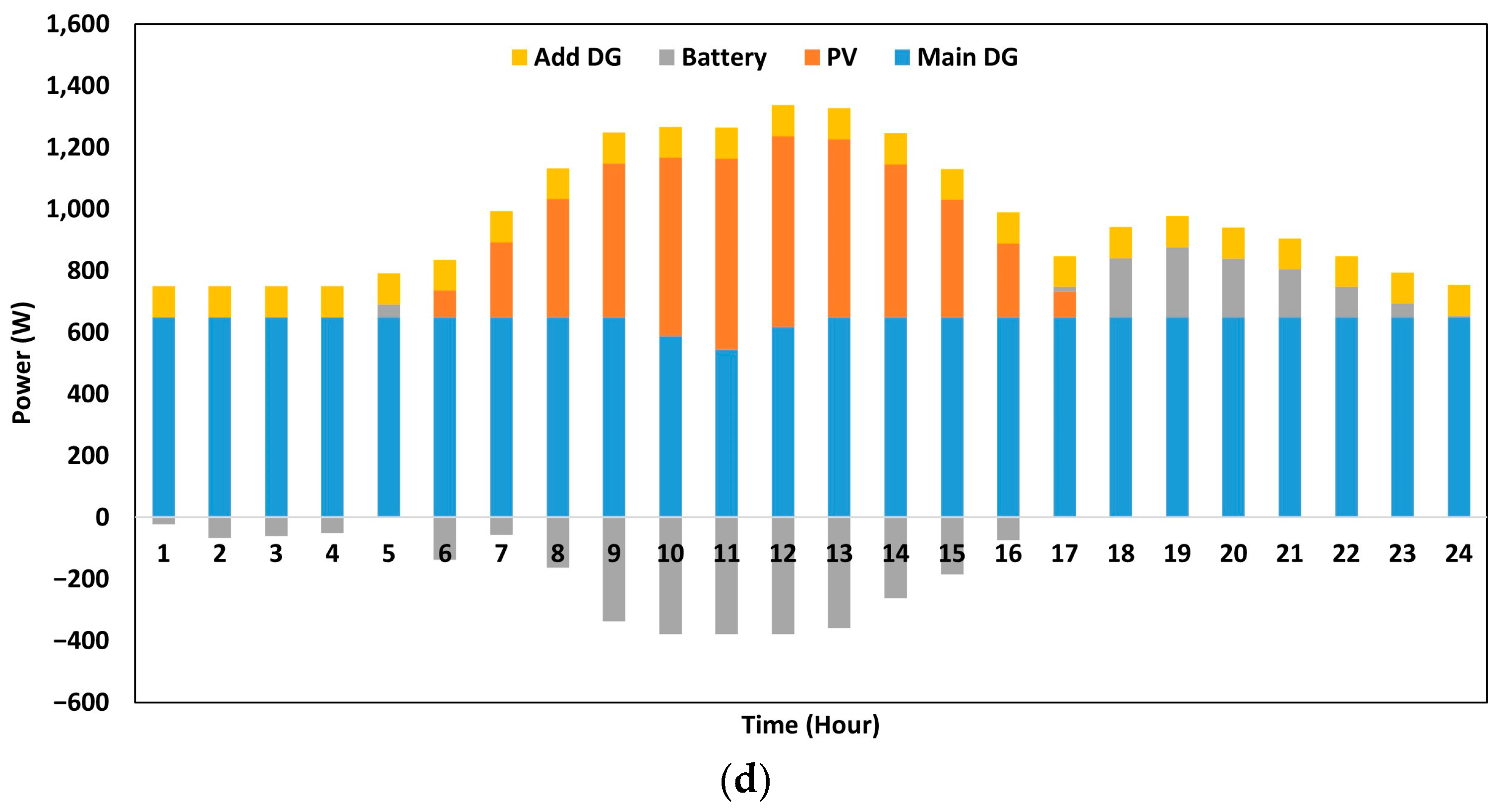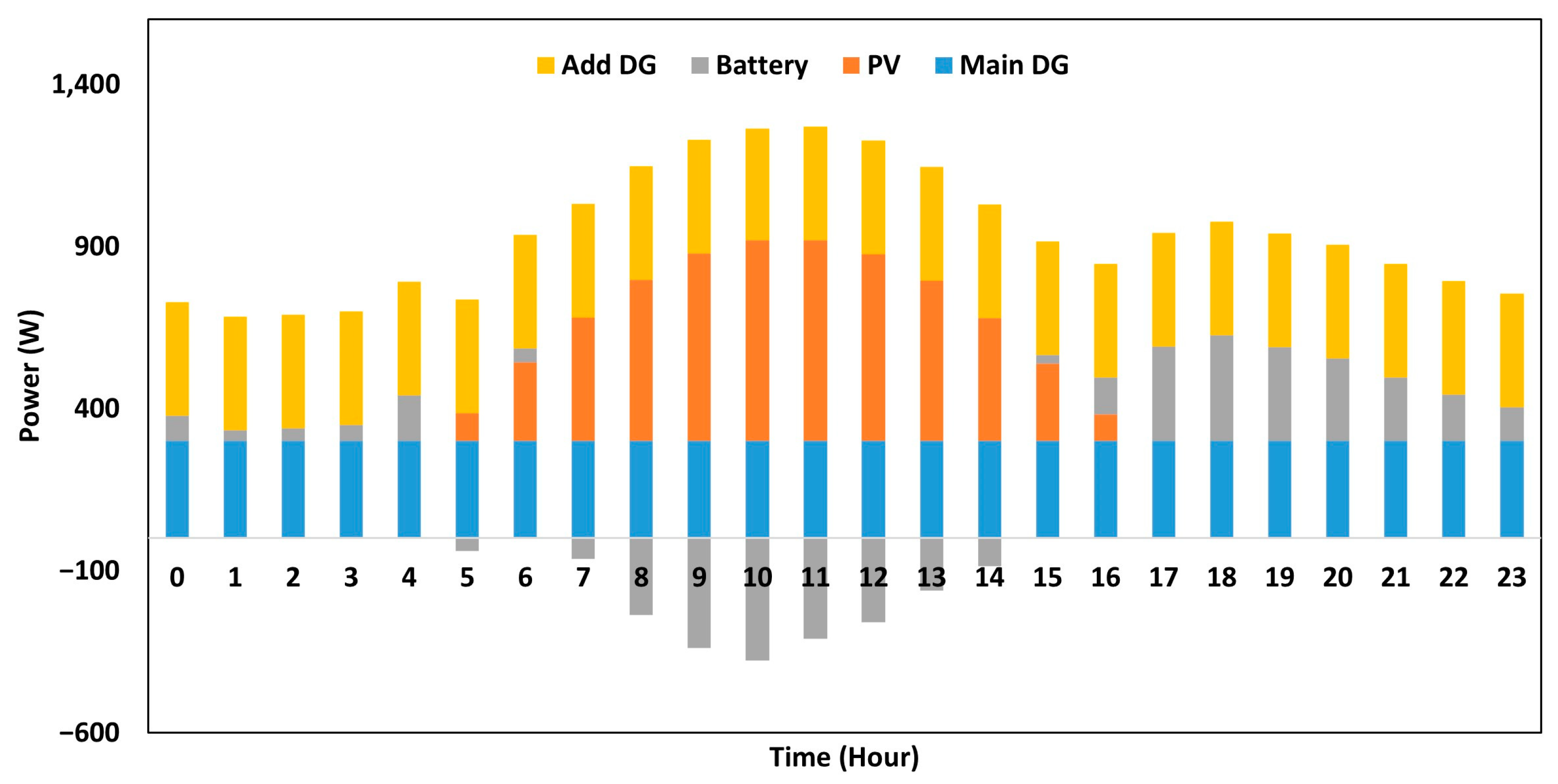1. Introduction
The importance of utilizing renewable energy as a reliable and sustainable source of electricity cannot be denied in light of the significant environmental challenges associated with traditional fossil-fuel-based generation methods [
1]. Hybrid generation systems, which leverage multiple renewable resources, have emerged as a promising solution to mitigate the impact of climate change and decrease carbon dioxide emissions levels [
2].
For over three decades, renewable energy resources have been gaining increasing attention globally following scientific warnings of the dire consequences of global warming on our planet, which affects all inhabitants [
3]. Consequently, significant investments and research funding have been directed toward the development of reliable and sustainable renewable energy sources to replace traditional generation methods. Many countries are now prioritizing locally available renewable resources to meet their electricity needs and support the global goal of generating clean energy. Research efforts are ongoing towards developing novel methods for optimizing systems to maximize benefits. As part of this pursuit, electricity companies are increasingly incorporating renewable energy resources into their operations. Optimization algorithms have been successfully considered as a reliable and versatile tool that is widely used by researchers to provide optimum solutions for optimizing electricity networks. Electrical engineering researchers have effectively employed many algorithms to develop techniques for optimizing electrical networks [
4,
5,
6]. For instance, the improved sunflower optimization algorithm was utilized to optimize a distribution network considering the minimum losses and costs through capacitor allocation [
7]. A capacity ratio calculation method was presented in [
8] to optimize a standalone hybrid wind/PV system. Energy management strategies and their integrations in power systems were presented in [
9,
10], which provided in-depth investigations into selecting energy management systems (EMSs) for microgrids and their integrations based on their energy efficiency, robustness, storage, and generation capability using different optimization approaches. In the context of renewable-energy-based distribution generation units, Adel A. Abou El-Ela [
11] conducted an economic and environmental study on the IEEE 33 bus system and a 141 bus large-scale system using equilibrium optimization techniques.
Various meta-heuristic algorithms have been effectively utilized to optimize power networks, with a particular focus on minimizing costs and losses through the allocation of DGs, in addition to them being employed to determine the optimal size and location of, and computing the optimal generated power from, the DG in each bus while maintaining the minimum network losses [
12]. L.F. Grisales-Norena [
13] is worth mentioning as an example of using GA and the fuzzy-based approach towards finding the optimal operation and bus location of batteries and capacitor banks and comparing them. Nahar A. and Johnson A. made an analysis study using five meta-heuristic algorithms to optimize a Hybrid Renewable Energy Network, consisting of a PV system, wind turbine, and a biomass generator in Saudi Arabia [
14]. Previous publications presented some optimization techniques for the power network on Tomia Island. For instance, in [
15] the FA was used to optimize the existing system (DG/PV/Battery) by separately minimizing the costs and losses, and in [
16] FA and GA were utilized to minimize only the costs in the same existing system (DG/PV/Battery); the two aforementioned articles optimized the system without performing optimization analyses to generate the optimum power from each source and also without considering related performance indicators. In [
17], GA and PSO were applied to optimize a proposed system (wind turbine/PV/battery) that incorporated a wind turbine instead of the existing DG, taking into account wind speed fluctuations. In this research, the main contributions were:
Presenting optimization scenarios using FA, GA, PSO, and surrogate optimization algorithms to optimize the proposed DG allocation integration scenario (DG/PV/Battery/Add. DG) of the network on Tomia Island, as a scalable methodology applicable for radial systems.
Performing a multi-objective function optimization technique to minimize the losses and costs of the system, considering the Pareto optimality approach.
Generating the optimum power output from each source employing FA, GA, PSO, and surrogate optimization algorithms considering the Loss of Power Supply (LPSP) and the coefficient of determination (R2) performance indicators, which provided insights into the performance and reliability of the optimized system.
Problem Statement
The problem addressed in this research pertains to the optimization of the hybrid electricity network on the isolated island of Tomia, located within Wakatobi National Park in the southeastern region of Sulawesi, Indonesia. Wakatobi comprises four islands, namely Wangi-Wangi, Binongko, Tomia, which is the subject of this case study, and, finally, Kaledupa. Wakatobi is a UNESCO provisional world heritage site, and the population on this island is 94,846 people. The main objective was to provide a solution to improve the performance of the existing electricity network, while considering the unique challenges presented by the island’s isolated location [
18].
Tomia, an isolated island in Wakatobi National Park in Indonesia, was unable to be connected to the nearby national grid. To address this issue, a radial power network was established, and a 1.4 megawatt Mitsubishi DG served as the primary source of energy, which operated for a few hours every night. However, this was insufficient and could not satisfy the demanded load. Due to Indonesia’s tropical climate, solar energy can provide a reliable and consistent solution to the island’s electricity supply. As a result, four PV stations were connected to the radial network, which resulted in the establishment of a hybrid network that provides electricity availability 24 h a day.
The electricity network under investigation in this study is a 20 kV radial system comprising 21 buses. Each bus is equipped with a 20 kV/400 V distribution transformer to supply the load, as illustrated in
Figure 1. The primary source of electricity is a 1400 kW Mitsubishi DG connected to the network. The network has also been supplemented with four photovoltaic (PV) farms and battery systems located in four different locations, namely Lamangau (224 kWp), Kahianga (308 kWp), Dete (112 kWp), and Kulati (140 kWp).
The FBSM was used as a power flow calculation method to determine the active and reactive powers, and sensitivity analysis was considered for the optimum DG location and size [
19,
20]. In addition, optimization algorithms were utilized to generate the optimum output power from each source at each hour. The obtained results can be used to optimize the system and satisfy the whole island’s demanded power over the entire day [
21].
This study provides an optimal solution, considering our investigations and comparisons of the achievements of FA, GA, PSO, and surrogate optimization techniques for optimizing radial power networks while minimizing costs and losses.
2. Methodologies
This section outlines the methodologies employed to achieve the best results using the four algorithms mentioned earlier. Each algorithm has its unique performance and operating procedures, based on its underlying natural or formulated standards.
We maximized the exploitation of solar radiation to decrease the load on the existing DG and reduce the burden by making it cover 30–35% of the total demanded power.
This approach reduced the overall costs and minimized CO
2 emissions on Tomia island while contributing to the conservation of Wakatobi National Park [
22,
23].
The designed objective function of this research is the cost function, with the primary goal of operating the system at the lowest possible cost and level of network losses. The inter-bus distances and cable types used in the electricity network of Tomia are described, as shown in
Figure 1. The primary DG was connected to the slack bus, which was essential to determine power flow calculations [
20]. Distances between each two buses were used to determine the actual resistance (
R) values and reactance (
X) values to be included in the power flow and losses calculations.
The cable type used in this network is an All-Aluminum-Alloy-Conductor (AAAC) with a cross-sectional area of 35 mm2. The values of the AC resistance and the inductive resistance are 1.05 ohm/km and 0.295 ohm/km, respectively, which were used to measure the R and X values for all line sections.
2.1. Solar Radiation Analysis
The power generated from solar radiation was calculated using the instantaneous power formula as follows [
15,
24].
The generated instantaneous power in watts is represented by
Ppv (
t). The solar cell numbers that were set in Tomia PV farms are denoted by
Nm, while
ηg represents the PV panel efficiency. The surface area (m
2) of a single PV panel is denoted by
Am, and
Gtill (
t) represents the actual value of the hourly global solar irradiance calculated on a tilted surface. Liu and Jordan’s statistical method was used to calculate
Gtill (
t) [
25]. This method is a reliable means of calculating solar radiation values per hour based on Tomia’s daily solar radiation data [
26].
Estimating the extra-terrestrial daily insulation is a crucial aspect of this study. To accomplish this, we utilized the following formula to calculate the value of
H0, representing the extraterrestrial daily insulation that can be reached and sensed on a horizontal surface:
The sunset hour angle parameter,
ωs, is an essential factor in calculating the solar irradiance, where
δ is the solar declination (°). The calculation of
ωs is based on the following formula:
While
L is the latitude in degrees (°),
Ion, which has a unit of (
Btu/
hr-sqft), represents the values of the solar intensity at the normal incidence outside the atmosphere of the planet. The following formula is considered to calculate this parameter:
In this context, the parameter
r denotes the solar radiation intensity ratio, whereas
Isc represents the solar constant, which refers to an essential physical parameter that denotes the quantity of solar radiation received per unit area beyond the Earth’s atmosphere at the Earth’s mean distance from the Sun.
rd is calculated using:
In which ω represents the hour angle,
h is the solar angle, and
hour is the local time and equals:
The ratio of the average intensity of diffuse radiation to the extraterrestrial radiation intensity
kd is dimensionless and varied between (0.125 and 0.179); the monthly average daily diffuse radiation received on a horizontal surface
D′ equaled and the hourly average solar radiation
Idh can be calculated using:
2.2. Diesel Generator (DG)
The DG is an important component in the electricity generation networks and consists of a diesel engine coupled with an electrical generator.
It is a highly reliable and efficient option, especially in isolated standalone systems. The DG operates by utilizing fuel to produce electricity. The cost of fuel consumed (fuel cost (
FC)) can be computed using the following non-linear quadratic function [
27]:
While
a,
b, and
c represent the coefficients of the fuel costs,
PDG(j) is the DG-generated power at the
jth interval, and
Cf is the actual price of 1
L of fuel; the system’s parameters and components rates are shown in
Table 1.
2.3. Battery Modeling and Cost Function
Battery banks are working in tandem with PV panels when the electricity system operates without a DG. Battery banks start charging when the network’s generation power exceeds the load demand. The next formula is considered in obtaining the battery bank energy [
28].
While and are charge values obtained at times t and t − 1, respectively, is the inverter efficiency, δ is the hourly self-charge rate, is the battery’s charge efficiency, is the load demand, and is the extra energy or can be described as the battery lack energy.
2.4. Power Flow Calculations Using FBSM
The FBSM was utilized to perform power flow calculations for radial networks [
29]. This approach was developed to address the differential-algebraic system that arises from the maximum principle that defines the solution. And to calculate the losses, the resistance (
R) values and reactance (
X) values are required for each line, as mentioned above. Power flows in a radial system can be computed using a simplified set of floating equations, which allow for the calculation of voltage and current magnitudes, as well as active and reactive powers, using the following formulas [
16].
Plk+1 and
Qlk+1 represent the real values of the load power at bus
k + 1 and the reactive load power at bus
k + 1, respectively;
Pk and
Qk represent the active and the reactive power values going out from bus
k towards bus
k + 1;
Pk+1 and
Qk+1 represent the active and reactive powers values at bus
k + 1, respectively. The power loss between bus
k and bus
k + 1 was calculated using [
30].
Total losses are the summation of all losses in all lines; the FBSM follows two styles of operation, the Backward Sweep and Forward Sweep operation scenarios.
The Backward Sweep operation is designed to compute the current magnitudes or power values at each bus and is aligned with the voltage values. This process commences at the last bus and progresses towards the first bus, with the slack bus as the starting point. In this regard, the voltage during the backward propagation is considered as a constant to determine the required values. Notably, power values are transmitted in a retrograde manner along the feeder through the reverse path.
The Forward Sweep operation computes the voltage drop at each node while considering the current and power flow updates. This starts from the first bus and moves towards the last bus. The feeder in this case is radial and not a ring, hence requiring the implementation of forward and backward propagations together to obtain optimal power flow values. As the forward propagation takes place, the power at each feeder section remains constant based on the value obtained from the backward process. The Backward Sweep process is responsible for calculating the current magnitudes or power values at each bus, which correspond to the voltage values; the process starts from the last bus and moves towards the first bus, which is the slack bus, while the power values are being updated in backward propagation.
2.5. Minimizing the Network Losses
The most widely used methods to reduce network losses are: (1) Capacitor placement, which is suitable to be used for high-voltage networks and to improve the network’s stability in addition to performing power factor correction. (2) The feeder reconfiguration method is recommended as a loss minimization technique for low-voltage networks, and initiates by implementing the load transfer switching scenario, which leads to minimizing the losses. (3) DG allocation for medium-voltage networks, which is suitable for the network in this research [
31,
32]. DG allocation is a standard method for medium-voltage networks that considers the power losses analysis criteria, which can decrease the burdens and power demands on the network and provide voltage support [
33].
2.6. Loss of Power Supply Probability (LPSP)
The LPSP metric is a performance indicator that indicates performance reliability. It serves to identify instances where the generated power falls short and cannot meet the required load. The LPSP value ranges between 0 and 1, where LPSP = 0 implies that the system is fully capable of meeting the load profile. Conversely, LPSP = 1 indicates the system’s incapability to cover the required load.
LPSP is considered a valuable tool for assessing the performance and reliability of hybrid systems. The
LPSP value should not exceed 5%. The
LPSP equation is found in [
34,
35].
where
El is the value of the required load in kWh, and
Eg is the value of the generated power in kWh.
3. Optimization Algorithms
Meta-heuristic algorithms are better than deterministic algorithms due to their capability to optimize intricate constraints and multi-objective functions. They are known for their robustness, flexibility, and adaptability, and they can explore a larger search space and can potentially escape local optima by employing stochastic search strategies. In this section, the methodologies and the concept of the operation of the four selected optimization algorithms will be discussed.
3.1. Firefly Algorithm (FA)
Xin-She Yang is the creator of the FA inspired by the collective behavior of fireflies [
36]. The FA is one of the meta-heuristic techniques that have garnered attention on the way to solving optimization problems. The FA is an innovation based on the communication channels and movement patterns observed among firefly swarms in their search for nearby food, which was deemed the optimal solution.
Fireflies’ flashing lights serve as a communication tool, and when a firefly finds food, it becomes brighter and attracts other fireflies, regardless of their gender, as fireflies are unisex. This algorithm employs three essential parameters: attractiveness, movement, and distance between fireflies.
Attractiveness,
βr, represents the attraction between the fireflies, which indicates the influence occurring as a result of each firefly’s brightness, and the firefly light intensity indicates that a firefly reached the optimum solution, which is calculated using:
where
γ represents the absorption coefficient value, which identifies the amount of absorbed light and varies between 0 and 1.
β0 indicates the attraction that occurs at a distance,
r = 0, among the fireflies, and the distance between the brighter one and any other firefly is represented by the parameter
r.
Any two fireflies in the swarm,
i and
j, are separated by a distance,
rij; this distance is commonly identified as the Cartesian distance, and measured using:
xi and
xj are the locations of any two fireflies in the swarm,
d represents the dimension,
xi,k is the
ith firefly’s component spatial coordinates, and
xj,k represents the
jth firefly’s spatial location [
37]. The movement
xi, due to the attraction effect that occurred among any two fireflies, is:
As shown in the previous formula, the firefly movement equation comprises three key components. The first part,
xi, signifies the present firefly’s location when the distance
r equals zero. The second part quantifies the attractiveness degree among the brighter firefly and the others in the swarm. The third part integrates randomization into the movement in case a firefly has yet to reach the optimal solution or become brighter. Here,
rand represents an arbitrary number within the range of [0, 1]. A crucial input to the algorithm is the randomization parameter
α, which also varies between [0, 1]. Additionally,
β0, which initially equals 1.0, represents the attractiveness initial level (Algorithm 1).
| Algorithm 1 The FA pseudo-code used in this research. |
BeginNetwork limits and boundaries Objective function f(x) = cost function. Setting the population and generating the initial number of fireflies’ populations xi (I = 1, 2, … n) Defining light intensity (Ii) at the location of xi, light absorption, and randomization parameters while (t < maximum iteration) for i = 1: n for all n fireflies for j = 1: n for all n fireflies if (Ij > Ii) Firefly I will move towards the firefly j in the d dimension. end if Attractiveness amount changes within distance r based on (−λ * r). New solution evaluation and updating the new light intensity. end for j end for i Finding the current best and selecting the optimum solution Posting the optimum generated power per hour per each power source end while Optimum results and designed visualizations outcomes
End process |
3.2. Genetic Algorithm (GA)
In 1975, John Holland developed the GA as a nature-inspired optimization technique [
38]. Based on his understanding of natural selection in genetics, Holland defined the three key genetic operators of the algorithm, namely natural selection, mutation, and crossover. A fundamental concept underlying GA is the coding of variables as binary strings. In each iteration of generating new solutions, the algorithm utilizes previous solutions that best fit the problem, creating a stochastic information exchange structure to search for the optimum solution [
39]. Selection is the qualifying process to select the fit, surviving genes by employing and reduplicating them, whereas unfit genes cannot stay longer and die.
The gene selection types include roulette wheel, stochastic remainder considering replacement and without replacement, the part sum selection procedure, deterministic, and finally, n-member tournament. The widest selection type is the roulette wheel selection; individuals in this type select their fitness based on the probability selection, and two fit individuals are randomly chosen for the production and progeny step. One hundred slots are considered in this type of selection. Each individual has a selection probability. This percentage is the measurement tool for each individual’s number of slots in the wheel; each individual can get copies according to their corresponding probabilities.
Crossover is a genetic operator used in evolutionary algorithms to combine two or more parent solutions to create a new offspring. This step, involving selecting a random character from each parent solution and exchanging them with each other at a randomly selected position, also known as the crossover point, thereby creates a new solution. Some methods commonly used to initiate crossover procedures are single or multiple points, variable by variable, and uniform crossovers. The technique used chiefly for a binary-coded chromosome is a single- or multiple-point crossover method. The possibility for the crossover to have occurred is (70–80%), as the crossover does not commonly happen, and the fit individuals copied directly to produce a new population.
Mutation is a crucial step that examines all newly added individuals, which are either copied from the previous ones or generated through the crossover. This step is considered as a confirmation that newly developed individuals are not similar, which will help add new information or retrieve any data lost in the new population. If an allele is chosen for mutation, this allele can be replaced with a new value or can change its value in small amounts (Algorithm 2).
| Algorithm 2 The GA pseudo-code used in this research. |
Begin Network limits and boundaries Objective function f(x) = cost function. Setting the initial population number Ppop, and generating the initial population populations, α as population size, β as elitism rate, δ as iterations number, crossover probability, and γ for mutation rate. while generation < maximum generation Fitness population evaluation for i = 1: δ Elitism selection and selecting the best individuals end for i for i from elites to α as population size for j from 1 to crossover number select two randomly solutions and generate the best solution by- -one-point crossover, then save. end for j end for i for k from 1 to crossover number mutate all the bits of the best solutions considering the rate of mutation rate γ. if the solution is unfeasible update it with a feasible one and repair the current solution. end if updating the current solution. end for k update Ppop the current population end while Returning the best solution as the optimum generated power per hour per each power source. Optimum results and designed visualizations outcomes.
End process |
3.3. Particle Swarm Optimization (PSO)
PSO is a commonly employed and effective algorithm for resolving optimization problems. The algorithm was introduced by Eberhart and Kennedy in 1995, who were inspired by the collective movements of birds, swarms, and fish as they search for the best food sources and regions [
40]. The interaction between individuals within a population has been mathematically modeled to create an effective method for finding the optimal solution. The algorithm iteratively searches for the optimal solution by adjusting the positions of individuals, known as particles, and updating their velocity based on the best-known solution in the swarm. The algorithm’s performance relies on the parameter selection, including the number of particles, maximum velocity, and inertia weight. Each particle is a point in D-dimensional space and may represent the optimal solution. The position and velocity are calculated using:
The adjustment of velocity and particle location are expressed as:
where
rand() and
Rand() are random main parameters varying from [0, 1], and
w represents the value of inertia weight;
c1 and
c2 are position and velocity parameters based on the previous experiences [
41].
The algorithm incorporates two learning factors,
c1 and
c2, which determine the influence of a particle’s personal best position (
pi) and the best position among all particles (
gi), respectively. The cognitive parameter,
c1, represents the particle’s previous experience, while
c2 indicates the effect of historical particle experience in the swarm. A high value of
c2 compared to
c1 implies that the particle is more attracted to the best position, (
gi), among the population, rather than its own best position (
pi), and vice versa if
c1 is greater than
c2. These factors are defined mathematically to determine the extent of the influence of
pi and
gi on the optimization process (Algorithm 3).
| Algorithm 3 The PSO pseudo-code used in this research |
BeginNetwork limits and boundaries Objective function f(x) = cost function. Uniformly distribution initialization of particle’s position, pbest, gbest., Setting algorithm parameters N, xi, xu, c1, c2, imax, and f Initializing velocities vi, and the best particles positions x* and g* Chose randomly the values of the two parameters r1 and r2 for t = 1: maximum generation for i = 1: population size select two random numbers of r1, r2, and vo if Pi(t) < pbest (i,t) update the particle’s velocity vi end if if Pi(t < gbest (i,t) update the new position xi. end if update x* and g* end for i i = i + 1; end for t Returning the best solution as the optimum generated power per hour per each power source. Optimum results and designed visualizations outcomes.
End process |
3.4. Surrogate Optimization
One of the meta-model-based optimization methods is surrogate optimization, which falls under the umbrella of evolutionary computational techniques [
42]. It has been used by researchers to solve single and multi-objective optimization problems in the past two decades, in addition to solving constrained fitness functions. The evolution control strategy is widely used as a management strategy model. Fitness evolutions, local searches, mutations, and crossovers are parts of the surrogate operation scenarios, which are responsible for filtering the fit and unfit populations, and contain non-optimum solutions or unrelated ones [
43]. The re-evolution process is managing the population clustering and classifying the populations into fuzzy or crisp clusters. After running this pre-selection process, the best individuals among the population will be selected for the re-evolution; this influences the approximate error average, which identifies the model quality. The evaluation of surrogate quality is based on rank correlation and continuous partial correlation (Algorithm 4).
| Algorithm 4 The pseudo-code of the surrogate optimization algorithm used in this research |
BeginNetwork limits and boundaries Objective function f(x) = cost function. Initialization of experimental design, considering the values of the constant functions. Starting the optimization process, iteration starts till reaching a feasible point. Evaluating the response surface parameters and the corresponding values. Generate and calculate the candidate points. Remove the sampled points and regenerate new points until finding an unsampled ones. Select the best candidate point and use it to perform the simulation. Repeat until reaching the lowest objective function value. Return the best point found as the optimum generated power per hour per each power source. Optimum results and designed visualizations outcomes.
End process |
4. Results Using FA, GA, PSO, and Surrogate Optimization
In this section, a suite of optimization algorithms was employed to seek out the operation scenario that produces the optimum maximum output power from each electricity source, while simultaneously minimizing network losses and overall costs. The results, differences, evaluations, and advantages of each algorithm are presented in detail.
It is important to note that each algorithm employs a unique approach to searching and optimization, which must be carefully considered when selecting the algorithm and setting its parameters and constraints. The hourly solar radiation calculation followed the application of the Liu and Jordan statistical method illustrated in
Figure 2 and
Figure 3.
4.1. Problem Formulation and Objective Functions
For the optimization procedure, a multi-objective optimization approach using the Pareto optimal solution was used in this research due to its capability and reliability at solving non-linear equations and performing better convergence with high accuracy, in addition to directing our exploration towards achieving an effective, non-inferior, and permissible Pareto front, by demonstrating the non-dominated vectors [
44,
45,
46]. Two objective functions were considered in this research by combining them to analyze the consistency of the optimal DG sizing and location. Considering the minimum losses and costs of the proposed system, extensive simulations and optimizations were performed to determine the trade-off between power losses and operational costs.
The multi objective optimization approach can be defined as finding the value of the vector
* =
which can minimize
And based on the concept of non-dominate sorting, a set of the Pareto solutions which are the optimal solution were obtained. A point
* X can be considered as a Pareto optimal if for every
X and also
I = 1, 2, ……,
k.
While
and
are the inequality and equality constraints’ sets, respectively,
X identifies the feasible set of the decision vectors. In our proposed system, the first objective function is the sum of the cost functions of the four power sources utilized in this research, considering the Operational and Maintenance (O and M) costs, initial or investment costs, and the lifetime factor [
44,
47,
48]:
- 2.
F2: Total active power loss:
N is the number of the network’s branches; the cost of each power source is represented by coefficients
a,
b,
c, and
d, while
x refers to the total cost of the power generated in the network. All computational steps and mathematical calculations occurred utilizing MATLAB software. FA was the algorithm that needed a more extended time of from 10 to 20 min to perform a single search. And the shortest one was the surrogate. The optimization procedures can be seen in the flow chart in
Figure 4.
The algorithms were run using a Core i5 Windows laptop to optimize the proposed study; we noticed that the running time decreased from 30 to 40 percent when we used a Core i7 Windows laptop. The disparities and advantages of each algorithm employed are demonstrated, as stated earlier. The algorithm parameters and constraints were set up while adhering to the same limits’ boundaries and equality and inequality constraints for all algorithms, as described in
Table 2.
4.2. Total Optimum Generated Power, Minimum Costs and Network Losses
To minimize network losses, an additional DG was added to the system. The loss value, the optimum value of this additional DG, and the optimum bus location were determined, as illustrated in
Figure 5 and
Table 3. A Pareto optimality plot for the proposed system to search for the minimum losses and costs is shown in
Figure 6. GA, PSO, and surrogate optimization resulted in nearly identical loss analyses, and the size of the additional DGs were almost the same. The FA yielded the lowest loss value. In contrast, the FA took significantly longer, with an operating time of 451.85 s per iteration.
The results depicted in
Figure 7 demonstrate the optimum total generated power by the four algorithms, which satisfy the load requirements and adhere to the system’s constraints, except for the unrealistic outcomes produced by the PSO algorithm, which had a significant impact on generating the highest overall computed cost, with a value of 0.1983 USD/kWh. As explained in
Figure 8 and determined in
Table 3, this highest cost was expected, due to the illogical power generated from the four sources by PSO and its failure to comply with the system’s constraints, and as a result of the nature of the PSO in performing with tight constraints, as can be seen in
Figure 9c. In contrast, the hourly generated power using the FA, GA, and surrogate optimization algorithm was constrained, satisfying the load. With these three algorithms, LPSP and R2 values were within acceptable ranges, which directly impacted system costs, as shown in
Figure 8, where the minimum COE was generated by the GA at 0.13544 USD/kWh, followed by the FA at 0.1439 USD/kWh.
4.3. Optimum Generated Power Analyses of the Four Algorithms
Notably, and based on the system constraints, the total generated power for all power sources cannot exceed more than 10% above the total demanded. The system’s constraints were the same for the four algorithms. The variances observed in the optimal generated power for the FA and GA and PSO and surrogate algorithms are displayed in
Figure 9a,
Figure 9b,
Figure 9c, and
Figure 9d, respectively.
The most idealistic generated power was computed from the FA, GA, and surrogate algorithm. PSO-generated power was illogical, as described above and seen in
Figure 9c, due to its concept of searching for the optimum solution as a swarm moving together to search for the optimum solution, which is different from the FA, GA, and surrogate algorithm, which depend on individuals searching for the optimum solution. The results indicated that each algorithm suggested a DG size and optimum bus location to minimize network losses. FA suggested a DG size of 103 watts, while the GA and PSO and surrogate algorithms suggested DG sizes of 301.56 watts, 307.78 watts, and 302 watts, respectively. That is why, in order to optimize the system, a 300-watt additional DG can be inserted at bus no. 2. The optimum generated power values from each source using the FA, GA, PSO, and Surrogate optimization algorithms separately are presented in
Appendix A and
Table A1.
To overcome the stochastic performance of the four algorithms, as they are meta-heuristic algorithms, multiple runs of each algorithm and performed comprehensive comparisons and analyses were performed, and the total optimum generated power was almost the same at each run, as seen in an example showing this point in
Appendix B and presented in
Figure A1 and
Figure A2. The algorithms were run using a Core i5 Windows laptop to optimize the proposed study, and we noticed that the running time decreased from 30 to 40 percent when we used a Core i7 Windows laptop.
The disparities and advantages of each algorithm employed are demonstrated, as stated earlier. The algorithm parameters and constraints were set up while adhering to the same limits’ boundaries and equality and inequality constraints for all algorithms, as described in
Table 2.
Figure 10 shows the optimum generated power from each source using the four algorithms separately in optimizing the existing system on Tomia Island (DG/PV/Batteries), as seen in some of those results already published in our previous publications [
15,
16]. This represents the main scope of this paper, which seeks to optimize power generation by producing the optimum generated power for the proposed system of performing DG allocation (DG/PV/Batteries/Add.DG). The FA performed the best among the other algorithms by reducing the burden on the main DG by 30.48%. On the other hand, the GA and PSO and surrogate optimization reduced the burden on the main DG by 8.10%, 3.21%, and 1.17%, respectively, which are slightly lower achievements.
Figure 9c shows that the generated power from the PSO did not perform well; this was a result of the tight DG constraints used in the PSO algorithm. When the boundaries were tight, the search space became more constrained, limiting the exploration capabilities of the PSO algorithm. This led to premature convergence, where the algorithm settles on suboptimal solutions without fully exploring the available search space [
49]. That was why we re-performed the PSO algorithm by expanding the DG boundaries (300 W ≤ P
DG ≤ 900 W); then, PSO performed better, as shown in
Figure 11. The LPSP was 0.00023, and R
2 was equal to 1.
Overall, the results demonstrate that the four algorithms are effective optimization algorithms for minimizing network losses and costs on Tomia Island, when considering the nature of each algorithm in finding the optimum minima.
5. Conclusions and Future Works
This paper presented a research study to optimize a proposed operating scenario by performing DG allocation for the hybrid DG/PV/Battery/Add.DG radial network on Tomia Island using four optimization algorithms, namely the firefly, genetic, PSO, and surrogate optimization algorithms, considering minimizing the losses and costs using a multi-objective function technique. Real data were used, and differences with the existing DG/PV/Battery system were presented based on our previous publications regarding optimizing this existing system. The outcomes of optimizing the proposed system presented in this study showed that PSO generated higher power than the required load in some hours of the day; that was a result of the tight DG constraints, resulting in an LPSP value that exceeded the 5% limit and a low coefficient of determination R2, which equals 0.5128. On the other hand, PSO performed better when we increased the constraints’ space. Pareto optimization was performed to optimize this multi-objective function for the loss and cost operation.
In conclusion, and based on the results, the GA performed the best by generating the minimum COE, with a value of 0.13544 USD/kWh, followed by the FA with a value of 0.1439 USD/kWh; the difference was slight and cannot be used to determine the superiority of one algorithm against the other. Thus, inserting a 300-watt additional DG at bus no. 2 can optimize the system while minimizing losses and satisfying the load, leading to cost savings.
In some outcomes, it can be seen that each algorithm performed better when considering the nature of each algorithm to find the minimum optima. Differences are discussed above, as well as suggestions for better performance for PSO, generating optimum power, and minimizing the total loss costs. All algorithms were run under the same boundary limits and system constraints.
Since Tomia Island is a part of Wakatobi National Park, a future study will eliminate the 1.4 MW DG and perform analyses using a wind turbine with the same rated power to decrease the CO2 emissions in this national park, and will consider the wind fluctuations in the rainy and dry seasons.
Author Contributions
Conceptualization, M.E.S.A. and C.C.-i.; Formal analysis, M.E.S.A.; Methodology, M.E.S.A., D.C.R. and C.C.-i.; Resources, M.E.S.A. and D.C.R.; Software, M.E.S.A. and C.C.-i.; Supervision, C.C.-i.; Writing—original draft, M.E.S.A.; Writing—review and editing, C.C.-i. All authors have read and agreed to the published version of the manuscript.
Funding
The computing and analyses in this research have been supported by King Mongkut’s Institute of Technology Ladkrabang (KMITL), KMITL School of Engineering, through the KMITL Ph.D. scholarship program [KSD2020/051].
Institutional Review Board Statement
Not applicable.
Informed Consent Statement
Not applicable.
Data Availability Statement
The data used to perform this study are available and will be provided upon reasonable request.
Acknowledgments
This work was supported by King Mongkut’s Institute of Technology Ladkrabang (KMITL) through the KMITL Ph.D. scholarship program [KSD2020/051].
Conflicts of Interest
The authors declare no conflict of interest.
Nomenclatures and Abbreviations
| FA | Firefly algorithm |
| GA | Genetic algorithm |
| PSO | Particle swarm optimization |
| DG | Diesel generator |
| PV | Photovoltaic cell |
| COE | Cost of Energy (USD/kWh) |
| LPSP | Loss of Power Supply Probability |
| FBSM | Forward-backward sweep method |
| R2 | Coefficient of determination |
| O&M | Operational and maintenance |
| FC | Fuel cost |
| Cost Fn. | Cost function |
| W | Watt |
| Ppv (t) | The generated instantaneous power at time t in watts |
| Nm | Solar cell numbers that had been set on Tomia Island |
| ηg | PV panel efficiency |
| Am | The surface area (m2) of a single PV panel |
| Gtill (t) | The actual value of the hourly global solar irradiance calculated on a tilted surface |
| Ho | The daily insulation that can be reached and sensed on a horizontal surface |
| ωs | Sunset hour angle parameter |
| L | The latitude in degrees (°) |
| Ion | The values of the solar intensity at the normal incidence outside the atmosphere of the planet (Btu/hr-sqft) |
| Isc | The solar constant |
| ω | The true solar time |
| Cf | The actual price of a 1 L of fuel |
| βr | Firefly attractiveness parameter |
| β0 | The attraction occurs at a distance r = 0 among the fireflies |
| rij, | the distance between two fireflies i and j |
| xi | The firefly’s movement due to the attraction effect occurring among any two fireflies |
| Ii | The light intensity of firefly i |
| rand() | PSO’s random main parameter |
| c1,c2 | PSO’s position and velocity parameters |
| pi | PSO’s particle best position |
| gi | PSO’s best position among all particles |
| Rk | Resistance at bus k |
| Xk | Reactance at bus k |
| Pk | Active power at bus k |
| Qk | Reactive power at bus k |
| Ploss(k,k+1) | Active power losses in the line between bus k and k + 1 |
| Qloss(k,k+1) | Reactive power losses in the line between bus k and k + 1 |
| PDG | Diesel generator (DG)-generated power in watts |
| PBatt | Battery generated power in watts |
| PAdd.DG | Additional DG-generated power in watts |
| Pload | The load power |
| h | hour |
Appendix A
In this appendix, find the values of the optimum total generated power generated by each source per hour using the four algorithms presented in this study; the differences are shown in
Table A1. The system boundaries and constraints were the same for all algorithms to satisfy the demanded load.
Table A1.
The total generated power from the four power sources per hour using each algorithm.
Table A1.
The total generated power from the four power sources per hour using each algorithm.
| Hour | Load (Watt) | Firefly Algorithm (FA) | Genetic Algorithm (GA) | Particle Swarm
Optimization (PSO) | Surrogate Optimization Algorithm |
|---|
| Total Generated Power (Watt) | Cost (USD/kWh) | Total Generated Power (Watt) | Cost (USD/kWh) | Total Generated Power (Watt) | Cost (USD/kWh) | Total Generated Power (Watt) | Cost (USD/kWh) |
|---|
| 0 | 661.1 | 727.209978 | 0.1550 | 727.209008 | 0.1291 | 727.21 | 0.1148 | 627.21 | 0.1553 |
| 1 | 621.5 | 683.649864 | 0.1478 | 683.649057 | 0.1199 | 683.654143 | 0.1038 | 583.65 | 0.1437 |
| 2 | 625.9 | 688.48988 | 0.1297 | 688.489008 | 0.1146 | 688.49 | 0.1045 | 588.49 | 0.1450 |
| 3 | 635.8 | 699.380146 | 0.1392 | 699.379003 | 0.1238 | 699.38 | 0.1074 | 599.38 | 0.1479 |
| 4 | 719.4 | 791.33997 | 0.1573 | 791.33902 | 0.1472 | 791.34 | 0.1319 | 691.34 | 0.1723 |
| 5 | 633.6 | 696.960456 | 0.1282 | 696.959542 | 0.1116 | 1083.36422 | 0.2180 | 596.96 | 0.1342 |
| 6 | 850 | 934.998014 | 0.1344 | 935.001934 | 0.1497 | 1240.12921 | 0.2358 | 835 | 0.1738 |
| 7 | 880 | 968.003067 | 0.1366 | 967.999007 | 0.1352 | 1379.76377 | 0.2518 | 868 | 0.1613 |
| 8 | 828 | 910.798192 | 0.1288 | 910.799011 | 0.1039 | 1495.21420 | 0.2650 | 810.8 | 0.1285 |
| 9 | 808 | 888.801155 | 0.1071 | 888.799 | 0.0881 | 1576.11588 | 0.2742 | 788.8 | 0.1160 |
| 10 | 805 | 885.50056 | 0.1032 | 885.499001 | 0.0818 | 1617.71834 | 0.2789 | 785.5 | 0.1130 |
| 11 | 872 | 959.198576 | 0.1169 | 959.199011 | 0.0989 | 1617.28648 | 0.2789 | 859.2 | 0.1258 |
| 12 | 880 | 968.001444 | 0.1032 | 967.999025 | 0.1084 | 1574.82030 | 0.2740 | 868 | 0.1316 |
| 13 | 894 | 983.401981 | 0.1436 | 983.399 | 0.1242 | 1493.34281 | 0.2647 | 883.4 | 0.1481 |
| 14 | 858.9 | 944.790611 | 0.1293 | 944.789 | 0.1321 | 1378.18029 | 0.2516 | 844.79 | 0.1554 |
| 15 | 831.5 | 914.651151 | 0.1332 | 914.649053 | 0.1422 | 1237.10619 | 0.2355 | 814.65 | 0.1688 |
| 16 | 770 | 846.999986 | 0.1643 | 846.99901 | 0.1492 | 1080.19725 | 0.2176 | 747 | 0.1747 |
| 17 | 855.8 | 941.381065 | 0.1845 | 941.379005 | 0.1834 | 998 | 0.2082 | 841.38 | 0.2123 |
| 18 | 887.7 | 976.469895 | 0.1903 | 976.469014 | 0.1905 | 998 | 0.2082 | 876.47 | 0.2216 |
| 19 | 853.6 | 938.960196 | 0.1944 | 938.959002 | 0.1859 | 938.96 | 0.1712 | 838.96 | 0.2116 |
| 20 | 822.8 | 905.079953 | 0.1873 | 905.079001 | 0.1791 | 905.08 | 0.1622 | 805.08 | 0.2026 |
| 21 | 770 | 847.000032 | 0.1615 | 846.999 | 0.1643 | 847 | 0.1467 | 747 | 0.1872 |
| 22 | 721.6 | 793.760106 | 0.1348 | 793.759124 | 0.1502 | 793.76 | 0.1325 | 693.76 | 0.1730 |
| 23 | 685.3 | 753.830701 | 0.1412 | 753.829 | 0.1376 | 753.83 | 0.1219 | 653.83 | 0.1623 |
Appendix B
The total generated power for 5 runs using PSO for both performances, the first with the same system DG boundaries (420 W ≤ PDG ≤ 650 W), and the second after expanding the DG boundaries to give a space for the algorithm to search for the optimal solution (300 W ≤ PDG ≤ 900 W).
Figure A1.
Total generated power after performing 5 runs considering same system’s DG boundaries using PSO.
Figure A1.
Total generated power after performing 5 runs considering same system’s DG boundaries using PSO.
Figure A2.
Total generated power after performing 5 runs using the consideration of expanding DG boundaries implemented to the PSO algorithm.
Figure A2.
Total generated power after performing 5 runs using the consideration of expanding DG boundaries implemented to the PSO algorithm.
References
- Hoad, D. The 2015 Paris Climate Agreement: Outcomes and their impacts on small island states. Isl. Stud. J. 2016, 11, 315–320. [Google Scholar] [CrossRef]
- Kemmoku, Y.; Ishikawa, K.; Nakagawa, S.; Kawamoto, T.; Sakakibara, T. Life cycle CO2 emissions of a photovoltaic/wind/diesel generating system. Electr. Eng. Jpn. 2002, 138, 14–23. [Google Scholar] [CrossRef]
- Liang, H.; Zhuang, W. Stochastic modeling and optimization in a microgrid: A survey. Energies 2014, 7, 2027–2050. [Google Scholar] [CrossRef]
- Al-Falahi, M.D.; Jayasinghe, S.; Enshaei, H. A review on recent size optimization methodologies for standalone solar and wind hybrid renewable energy system. Energy Convers. Manag. 2017, 143, 252–274. [Google Scholar] [CrossRef]
- Bahramara, S.; Moghaddam, M.P.; Haghifam, M.R. Optimal planning of hybrid renewable energy systems using HOMER: A review. Renew. Sustain. Energy Rev. 2016, 62, 609–620. [Google Scholar] [CrossRef]
- Khare, V.; Nema, S.; Baredar, P. Solar–wind hybrid renewable energy system: A review. Renew. Sustain. Energy Rev. 2016, 58, 23–33. [Google Scholar] [CrossRef]
- Shaheen, A.M.; Elattar, E.E.; El-Sehiemy, R.A.; Elsayed, A.M. An improved sunflower optimization algorithm-based Monte Carlo simulation for efficiency improvement of radial distribution systems considering wind power uncertainty. IEEE Access 2020, 9, 2332–2344. [Google Scholar] [CrossRef]
- Yang, Y.; Wei, Q.; Liu, S.; Zhao, L. Distribution strategy optimization of standalone hybrid WT/PV system based on different solar and wind resources for rural applications. Energies 2022, 15, 5307. [Google Scholar] [CrossRef]
- El-Ela, A.A.A.; El-Sehiemy, R.A.; Shaheen, A.M.; Ellien, A.R. Review on Active Distribution Networks with Fault Current Limiters and Renewable Energy Resources. Energies 2022, 15, 7648. [Google Scholar] [CrossRef]
- Shafiullah, M.; Refat, A.M.; Haque, E.; Chowdhury, D.M.H.; Hossain, S.; Alharbi, A.G.; Alam, S.; Ali, A.; Hossain, S. Review of Recent Developments in Microgrid Energy Management Strategies. Sustainability 2022, 14, 14794. [Google Scholar] [CrossRef]
- El-Ela, A.A.A.; El-Sehiemy, R.A.; Allam, S.M.; Shaheen, A.M.; Nagem, N.A.; Sharaf, A.M. Renewable Energy Micro-Grid Interfacing: Economic and Environmental Issues. Electronics 2022, 11, 815. [Google Scholar] [CrossRef]
- Ganguly, S.; Samajpati, D. Distributed generation allocation on radial distribution networks under uncertainties of load and generation using genetic algorithm. IEEE Trans. Sustain. Energy 2015, 6, 688–697. [Google Scholar] [CrossRef]
- Grisales-Noreña, L.F.; Montoya, O.D.; Gil-Gonzalez, W. Integration of energy storage systems in AC distribution networks: Optimal location, selecting, and operation approach based on genetic algorithms. J. Energy Storage 2019, 25, 100891. [Google Scholar] [CrossRef]
- Alshammari, N.; Asumadu, J. Comparative Analysis of Meta-Heuristic Algorithms for Optimal Sizing of Hybrid Renewable Energy System. In Proceedings of the 2020 IEEE International Conference on Electro Information Technology (EIT), Chicago, IL, USA, 31 July 2020–1 August 2020; pp. 648–654. [Google Scholar]
- Abdelwareth, M.E.S.; Robandi, I.; Riawan, D.C.; Wibowo, R.S. Minimizing the Losses and the Cost of a Radial Network using Firefly algorithm: A real case study Diesel-PV-Batteries Hybrid system of Tomia Island, Southeast Sulawesi, Indonesia. In Proceedings of the 2019 International Conference on Computer Engineering, Network, and Intelligent Multimedia (CENIM), Surabaya, Indonesia, 19–20 November 2019; pp. 1–5. [Google Scholar]
- Abdelwareth, M.E.S.; Riawan, D.C.; Chompoo-Inwai, C. Optimum Generated Power with the Minimum Cost of a Radial Network using Firefly and Genetic Algorithms. In Proceedings of the 2021 International Conference on Power, Energy and Innovations (ICPEI), Nakhon Ratchasima, Thailand, 20–22 October 2021; pp. 25–28. [Google Scholar]
- Abdelwareth, M.E.S.; Riawan, D.C.; Chompoo-Inwai, C. Optimum Operation and Cost Scenarios of a Hybrid Wind/PV/Battery in a Radial Network using Genetic Algorithm and Particle Swarm Optimization. In Proceedings of the 2022 International Conference on Power, Energy and Innovations (ICPEI), Pattaya Chonburi, Thailand, 19–21 October 2022; pp. 1–4. [Google Scholar]
- wikipedia.org. Wakatobi National Park. Available online: https://en.wikipedia.org/wiki/Wakatobi_National_Park (accessed on 23 February 2010).
- Abu-Mouti, F.S.; El-Hawary, M.E. A new and fast power flow solution algorithm for radial distribution feeders including distributed generations. In Proceedings of the 2007 IEEE International Conference on Systems, Man and Cybernetics, Montreal, QC, Canada, 7–10 October 2007; pp. 2668–2673. [Google Scholar]
- Kashem, M.; Le, A.; Negnevitsky, M.; Ledwich, G. Distributed generation for minimization of power losses in distribution systems. In Proceedings of the 2006 IEEE Power Engineering Society General Meeting, Montreal, QC, Canada, 18–22 June 2006; p. 8. [Google Scholar]
- Zhao, B.; Zhang, X.; Li, P.; Wang, K.; Xue, M.; Wang, C. Optimal sizing, operating strategy and operational experience of a stand-alone microgrid on Dongfushan Island. Appl. Energy 2014, 113, 1656–1666. [Google Scholar] [CrossRef]
- Bilal, B.O.; Sambou, V.; Kébé, C.M.F.; Ndiaye, P.A.; Ndongo, M. Methodology to Size an Optimal Stand-Alone PV/wind/diesel/battery System Minimizing the Levelized cost of Energy and the CO2 Emissions. Energy Procedia 2012, 14, 1636–1647. [Google Scholar] [CrossRef]
- Jakhrani, A.Q.; Rigit, A.R.H.; Othman, A.K.; Samo, S.R.; Kamboh, S.A. Estimation of carbon footprints from diesel generator emissions. In Proceedings of the 2012 International Conference on Green and Ubiquitous Technology, Bandung, Indonesia, 7–8 July 2012; pp. 78–81. [Google Scholar]
- Noguera, A.L.G.; Castellanos, L.S.M.; Lora, E.E.S.; Cobas, V.R.M. Optimum design of a hybrid diesel-ORC/photovoltaic system using PSO: Case study for the city of Cujubim, Brazil. Energy 2018, 142, 33–45. [Google Scholar] [CrossRef]
- Liu, B.Y.; Jordan, R.C. The interrelationship and characteristic distribution of direct, diffuse and total solar radiation. Sol. Energy 1960, 4, 1–19. [Google Scholar] [CrossRef]
- Louzazni, M.; Craciunescu, A.; Dumitrache, A. Identification of Solar Cell Parameters with Firefly Algorithm. In Proceedings of the 2015 Second International Conference on Mathematics and Computers in Sciences and in Industry (MCSI), Sliema, Malta, 17 August 2015; pp. 7–12. [Google Scholar]
- Kusakana, K. Operation cost minimization of photovoltaic–diesel–battery hybrid systems. Energy 2015, 85, 645–653. [Google Scholar] [CrossRef]
- Maleki, A.; Pourfayaz, F. Optimal sizing of autonomous hybrid photovoltaic/wind/battery power system with LPSP technology by using evolutionary algorithms. Sol. Energy 2015, 115, 471–483. [Google Scholar] [CrossRef]
- Grisales-Noreña, L.F.; Garzon-Rivera, O.D.; Ramírez-Vanegas, C.A.; Montoya, O.D.; Ramos-Paja, C.A. Application of the backward/forward sweep method for solving the power flow problem in DC networks with radial structure. In Journal of Physics: Conference Series; IOP Publishing: Bristol, UK, 2020; Volume 1448, p. 012012. [Google Scholar]
- Rupa, J.M.; Ganesh, S. Power flow analysis for radial distribution system using backward/forward sweep method. Int. J. Electr. Comput. Electron. Commun. Eng. 2014, 8, 1540–1544. [Google Scholar]
- Devabalaji, K.; Imran, A.M.; Yuvaraj, T.; Ravi, K. Power loss minimization in radial distribution system. Energy Procedia 2015, 79, 917–923. [Google Scholar] [CrossRef]
- Rao, R.S.; Ravindra, K.; Satish, K.; Narasimham, S.V.L. Power loss minimization in distribution system using network reconfiguration in the presence of distributed generation. IEEE Trans. Power Syst. 2012, 28, 317–325. [Google Scholar] [CrossRef]
- Nadhir, K.; Chabane, D.; Tarek, B. Firefly algorithm based energy loss minimization approach for optimal sizing & placement of distributed generation. In Proceedings of the 2013 5th International Conference on Modeling, Simulation and Applied Optimization (ICMSAO), Hammamet, Tunisia, 28–30 April 2013; pp. 1–5. [Google Scholar]
- Abouzahr, I.; Ramakumar, R. Loss of power supply probability of stand-alone photovoltaic systems: A closed form solution approach. IEEE Trans. Energy Convers. 1991, 6, 1–11. [Google Scholar] [CrossRef] [PubMed]
- Aziz, N.I.A.; Sulaiman, S.I.; Shaari, S.; Musirin, I.; Sopian, K. Optimal sizing of stand-alone photovoltaic system by minimizing the loss of power supply probability. Sol. Energy 2017, 150, 220–228. [Google Scholar] [CrossRef]
- Yang, X.S. Nature-Inspired Metaheuristic Algorithms; Luniver Press: Frome, UK, 2010; Volume 10, pp. 81–89. [Google Scholar]
- Kaabeche, A.; Diaf, S.; Ibtiouen, R. Firefly-inspired algorithm for optimal sizing of renewable hybrid system considering reliability criteria. Sol. Energy 2017, 155, 727–738. [Google Scholar] [CrossRef]
- Holland, J.H. Adaptation in Natural and Artificial Systems: An Introductory Analysis with Applications to Biology, Control, and Artificial Intelligence; U Michigan Press: Ann Arbor, MI, USA, 1975. [Google Scholar]
- Swarup, K. Genetic algorithm for optimal capacitor allocation in radial distribution systems. In Proceedings of the 6th WSEAS International Conference on Evolutionary, Lisbon, Portugal, 16–18 June 2005; pp. 152–159. [Google Scholar]
- Kennedy, J.; Eberhart, R. Particle swarm optimization. In Proceedings of the ICNN’95-International Conference on Neural Networks, Perth, WA, Australia, 27 November–1 December 1995; Volume 4, pp. 1942–1948. [Google Scholar]
- Zhang, W.; Liu, Y. Reactive power optimization based on PSO in a practical power system. In Proceedings of the IEEE Power Engineering Society General Meeting, Denver, CO, USA, 6–10 June 2004; pp. 239–243. [Google Scholar]
- Jin, Y. Surrogate-assisted evolutionary computation: Recent advances and future challenges. Swarm Evol. Comput. 2011, 1, 61–70. [Google Scholar] [CrossRef]
- Muenderlein, J.; Ipers, G.; Steinhoff, M.; Zurmuehlen, S.; Sauer, D.U. Optimization of a hybrid storage system and evaluation of operation strategies. Int. J. Electr. Power Energy Syst. 2020, 119, 105887. [Google Scholar] [CrossRef]
- Adewuyi, O.B.; Adeagbo, A.P.; Adebayo, I.G.; Howlader, H.O.R.; Sun, Y. Modified analytical approach for PV-DGs integration into a radial distribution network considering loss sensitivity and voltage stability. Energies 2021, 14, 7775. [Google Scholar] [CrossRef]
- Adewuyi, O.B.; Shigenobu, R.; Senjyu, T.; Lotfy, M.E.; Howlader, A.M. Multiobjective mix generation planning considering utility-scale solar PV system and voltage stability: Nigerian case study. Electr. Power Syst. Res. 2019, 168, 269–282. [Google Scholar] [CrossRef]
- Sivasubramani, S.; Swarup, K.S. Multi-objective harmony search algorithm for optimal power flow problem. Int. J. Electr. Power Energy Syst. 2011, 33, 745–752. [Google Scholar] [CrossRef]
- Elnozahy, A.; Yousef, A.M.; Ghoneim, S.S.M.; Abdelwahab, S.A.M.; Mohamed, M.; Abo-Elyousr, F.K. Optimal Economic and Environmental Indices for Hybrid PV/Wind-Based Battery Storage System. J. Electr. Eng. Technol. 2021, 16, 2847–2862. [Google Scholar] [CrossRef]
- Nadjemi, O.; Nacer, T.; Hamidat, A.; Salhi, H. Optimal hybrid PV/wind energy system sizing: Application of cuckoo search algorithm for Algerian dairy farms. Renew. Sustain. Energy Rev. 2017, 70, 1352–1365. [Google Scholar] [CrossRef]
- Chu, W.; Gao, X.; Sorooshian, S. Handling boundary constraints for particle swarm optimization in high-dimensional search space. Inf. Sci. 2011, 181, 4569–4581. [Google Scholar] [CrossRef]
| Disclaimer/Publisher’s Note: The statements, opinions and data contained in all publications are solely those of the individual author(s) and contributor(s) and not of MDPI and/or the editor(s). MDPI and/or the editor(s) disclaim responsibility for any injury to people or property resulting from any ideas, methods, instructions or products referred to in the content. |
© 2023 by the authors. Licensee MDPI, Basel, Switzerland. This article is an open access article distributed under the terms and conditions of the Creative Commons Attribution (CC BY) license (https://creativecommons.org/licenses/by/4.0/).
